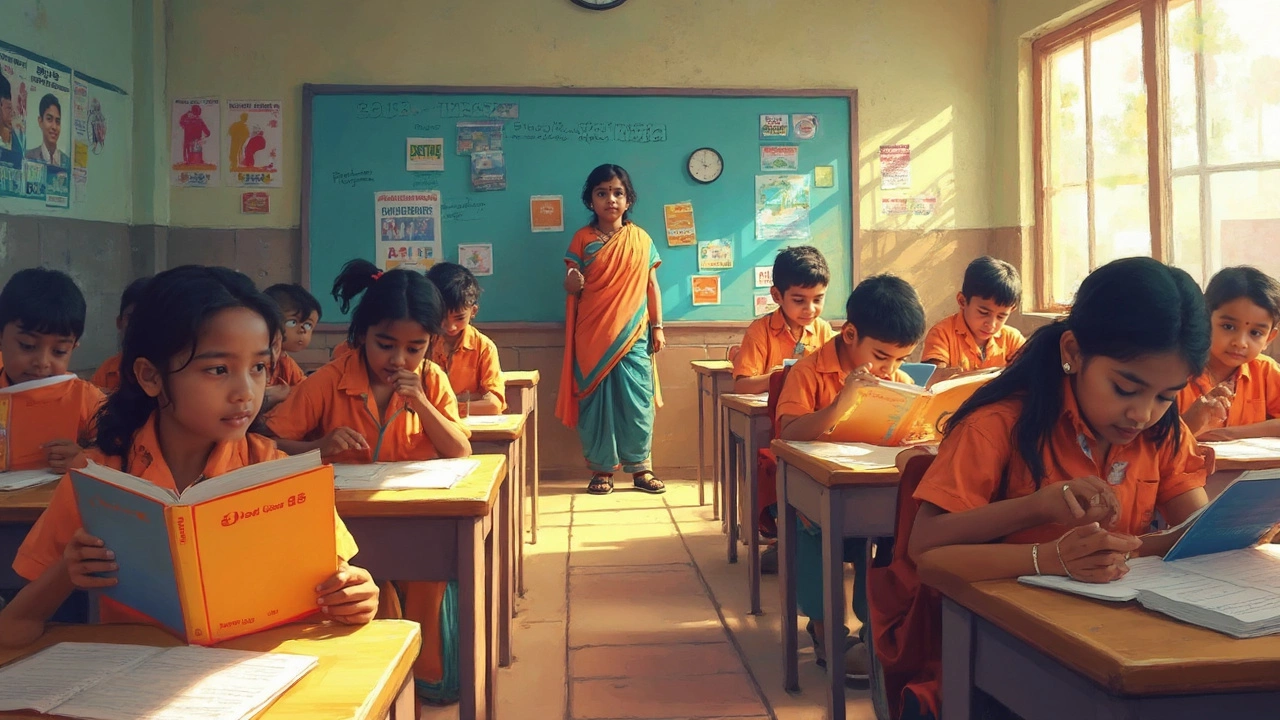Some things spark endless debate at dinner tables, and picking the right school board for your kid is one of them. The CBSE syllabus, though, keeps popping up as the go-to option for families across India. People aren’t just following a trend — there’s a logic behind it.
If you look at most big entrance exams in India, from medical to engineering, the question papers follow the CBSE style. That’s not a small thing if you’re thinking about long-term goals. It means students familiar with this syllabus aren’t thrown off when they face those high-pressure tests, which can be a make-or-break moment.
Another thing: you get a balance of theory and real-world application. CBSE isn’t all about cramming — those activity-based assignments and projects actually stick. My own son, Leander, gets pumped about science because the concepts actually feel doable, not like abstract gibberish.
- What Makes CBSE Different?
- Why Families and Students Lean Toward CBSE
- CBSE and Big Exams: The Competitive Edge
- National Mobility and Recognition
- Is CBSE the Right Fit? What to Consider
What Makes CBSE Different?
The CBSE board isn’t just another school system with a new set of textbooks. What actually sets it apart is how it’s built for real-world learning—no endless memorizing just for marks. CBSE follows a concept-based approach, meaning kids actually understand the “why” behind things instead of just cramming facts the night before exams.
CBSE’s curriculum is designed by the National Council of Educational Research and Training (NCERT), so you’re getting a standardized and updated syllabus across every city and state. The books focus on basic concepts and avoid tons of unnecessary information, making tougher topics feel less overwhelming.
Want to see how it stacks up? Take a look at this comparison of CBSE vs other boards:
| Feature | CBSE | State Boards | ICSE |
|---|---|---|---|
| Medium of instruction | English & Hindi | Mainly regional languages | English |
| Curriculum | NCERT books, concept-focused | Varies by state | More detailed, theory-heavy |
| National presence | Across India and in 28+ countries | Within one state | Mainly urban India & abroad |
| Exams style | Application & MCQs | Traditional, memory-focused | Detailed answers, stories |
CBSE’s exam format is also a winner for most kids. Since 2020, they’ve included more multiple-choice questions and case studies, which means you practice thinking on your feet rather than reciting textbook lines. This comes in super handy for board exams and those make-or-break entrance tests.
There’s another thing parents love: CBSE is designed for flexibility if your family needs to move between cities. The textbooks and standards are exactly the same everywhere, so you don’t get stuck re-learning half the year’s content just because you changed schools or states.
All of this boils down to a board that isn’t just about marks. It’s about understanding, and being ready for what comes next—whether that’s another grade, another school, or a big exam that decides your future.
Why Families and Students Lean Toward CBSE
When parents start digging around for the best schooling option, the CBSE board usually lands on top of the list. There’s real logic behind it—families want stability, options, and something that won’t cause chaos if they need to move cities or states for work. Since CBSE schools are spread all over India, kids can easily switch schools without having to adapt to a totally different system. It saves a lot of stress, and let’s be honest, nobody enjoys those mid-year surprises.
The teaching style in CBSE is more practical, which suits students with all kinds of dreams—arts, science, management, or even sports. Homework actually makes sense, and there’s a steady stream of activities that don’t just focus on marks but build confidence. Assessments aren’t only about rote learning; they check if students actually understand the basics. That makes it easier when it’s time to compete in Olympiads or international contests since concepts aren’t drilled just for memory but for skill.
CBSE textbooks, especially the NCERT series, are well-organized and straightforward. The language is simple and the flow is logical, so kids aren’t left scratching their heads. This kind of structure is a huge relief for families who want to help out with homework. I see this firsthand at home—Cassandra and I never feel lost when Leander asks for help, even on last-minute projects.
What’s also cool is that CBSE doesn’t overload students with extra, irrelevant stuff. The focus is sharp, and there are regular updates to keep the content modern and linked with the latest trends, which is why tech topics and skill-based subjects are now making their way into the syllabus. So students stay prepared, not just for exams, but also for a world that’s changing faster than anyone can predict.

CBSE and Big Exams: The Competitive Edge
When it comes to big career-defining tests in India, the CBSE syllabus has a real advantage. If you’re aiming for top exams like NEET (for medicine) or JEE (for engineering), you’ll notice their question patterns are almost borrowed straight from CBSE textbooks. This means kids who’ve tackled CBSE aren’t just cramming for the school year—they’re building a foundation for these national exams from day one.
Most entrance exams in India, including DU admissions, use the CBSE style for everything from subject focus to how answers are expected. The way CBSE frames topics—simple language, clear concepts, loads of sample questions and mock exams—actually mirrors what you’ll see on the real thing. That kind of alignment is hard to ignore.
Even the CBSE board papers get you ready for tough questions. They toss in practical case studies, assertion-reasoning types, and regularly change question formats. My nephew tells me these tricks kept him on his toes, so no question in NEET felt totally out of the blue.
Here’s what makes CBSE students stand out when it’s crunch time:
- Exam-focused materials: Textbooks double as entrance exam guides.
- Practice built-in: Topic-wise sample papers help you spot trends and tricky spots early.
- Consistent structure: Sticking with CBSE from junior to senior years means no last-minute surprises.
CBSE doesn’t just teach to the test, but it does get students comfortable with the style, pace, and expectations of India’s toughest entrance exams. That’s a big reason parents see this board as a safe bet when thinking long-term for their kids.
National Mobility and Recognition
Here’s the thing: if your family ever moves to another city for work, the CBSE tag can be a lifesaver. There are over 27,000 CBSE-affiliated schools in India and even a bunch overseas in places like Dubai and Singapore. That means you can switch cities—or even countries—without your kid starting from scratch. The syllabus, exams, and grading style stay the same.
It’s a relief for folks with transferable jobs (think government, banks, or the army). I’ve met parents who’ve shifted their kids between six cities, and the biggest stress was the packers, not the classroom. When Leander’s best friend’s family moved from Pune to Bangalore, he joined a new CBSE school and picked up right where he’d left off—no lost time, no curriculum gaps.
Recognition matters, too. CBSE’s assessment system is recognized by all major universities and colleges in India, including IITs, AIIMS, and national law schools. Everybody gets the marking style, so no weird conversion charts or explaining marksheets when it’s admission time.
| CBSE Presence (2024) | Numbers |
|---|---|
| Schools in India | 27,000+ |
| Schools Abroad | 240+ |
| Countries Covered | 28 |
Because the board is recognized by both the Indian government and education councils, students find it smoother to apply for scholarships and government exams, too. You’re not explaining your school board to anyone—everyone already knows it.

Is CBSE the Right Fit? What to Consider
Deciding if the CBSE syllabus works for your kid isn’t just about following the crowd. Let’s break down what actually helps you figure this out.
First, think about your child’s learning style. CBSE goes heavy on science, math, and languages. It’s designed for kids who don’t mind routine and structured exams, which means regular assessments and that famous final board exam in Class 10 and 12. If your child easily gets anxious with lots of tests, this can be stressful.
You’ll find that CBSE textbooks line up with national entrance exams like JEE and NEET. If higher studies in India’s top colleges are in the plans, this board gives a clear advantage. Schools abroad or different education styles? CBSE might not always vibe with the “learn through projects” approach you’ll see elsewhere.
Mobility is a real plus. Let’s say your family moves every couple of years, thanks to job transfers or other reasons. With thousands of CBSE schools across India (and even abroad), switching schools is way easier. You won’t need to worry about mismatched syllabuses or missed chapters when your child joins a new class mid-year.
Looking for English-medium learning? CBSE covers both Hindi and English, but in most schools, the medium is English. Good news if you want your child strong in both languages, but this might not work for families looking for instruction in another mother tongue, like Marathi or Tamil.
Cost can also play a part. CBSE schools come in all price brackets—government schools are often more affordable compared to big private institutions, so you have options whether you’re watching your budget or looking for fancy facilities.
- If your child plans to appear for competitive entrance exams in India, CBSE really helps.
- If your work makes you relocate often, CBSE offers smoother transfers.
- If your child is more into arts or vocational subjects, research carefully—CBSE’s focus is still mainly academics.
Take time to weigh your priorities as a family. You know your kid best. If structure, consistency, and national-level recognition are what matter most, CBSE checks all those boxes without surprises down the line.
